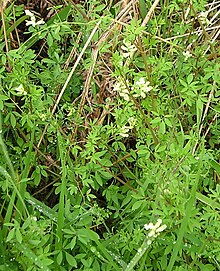Ceratocapnos claviculata, the climbing corydalis,[1] is a weak scrambling plant in the family Papaveraceae. It is endemic to Europe, growing mostly near the Atlantic fringe.[2]
| Climbing corydalis | |
|---|---|

| |
| Climbing corydalis | |
| Scientific classification | |
| Kingdom: | Plantae |
| Clade: | Tracheophytes |
| Clade: | Angiosperms |
| Clade: | Eudicots |
| Order: | Ranunculales |
| Family: | Papaveraceae |
| Genus: | Ceratocapnos |
| Species: | C. claviculata
|
| Binomial name | |
| Ceratocapnos claviculata | |
| Synonyms | |
Description edit
This delicate looking plant is a hairless annual (or occasionally perennial) up to a metre tall with weak, often pinkish, clambering stems. The leaves are pale to medium green, doubly compound, the leaflets being well-stalked and divided into three to five sub-leaflets, and ending in a branching tendril. It blooms between May and September in the UK.[3] The flowers are small, about 6 mm (0.24 in) long,[3] pale creamy-yellow, in short axilliary spikes. Each flower is elongated and tubular with a lip and spur and stamens in two bundles. The seed pods are short, usually narrowing between the two seeds.[4]
Taxonomy edit
It was first published as Ceratocapnos claviculata by Magnus Lidén in 'Anales Jard. Bot. Madrid' vol.41 on page 221 in 1984, based on an earlier description by Carl Linnaeus under the name Fumaria claviculata.[5][6]
The Latin specific epithet claviculata refers to having tendrils or being tendrilled.[7]
Distribution edit
This species is known from several countries in western Europe, Belgium, Denmark, France, Germany, Ireland, Netherlands, Spain, Portugal and Norway.[8] The largest proportion of the global population is found in the United Kingdom. It grows in most counties in Britain especially the more western ones, but is absent from Orkney, Shetland and the Outer Hebrides and rare in Ireland.[2] UK conservation status is least concern as of 2005.[9]
Ecology edit
Climbing corydalis tends to grow on the edges of woodlands and previously wooded sites. It prefers acid soils, sandy or peaty, and usually in sheltered and half shaded positions. It is sometimes abundant in disturbed parts of recently cleared plantations or woods, clambering over wood debris. It grows well in impoverished soil under bracken, perhaps because it flowers early in the year before the fronds develop fully.[2] It is the food plant for the weevil, Procas granulicollis and the beetle, Sirocalodes mixtus.[10] Pollination is by honey bees and bumblebees.[11]
References edit
- ^ BSBI List 2007 (xls). Botanical Society of Britain and Ireland. Archived from the original (xls) on 2015-06-26. Retrieved 2014-10-17.
- ^ a b c Botanical Society of Britain and Ireland Archived February 1, 2010, at the Wayback Machine
- ^ a b Reader's Digest Field Guide to the Wild Flowers of Britain. Reader's Digest. 1981. p. 36. ISBN 9780276002175.
- ^ McClintock, D. and Fitter, R. The Pocket Guide to Wild Flowers. Collins (1955)
- ^ "Ceratocapnos claviculata (L.) Lidén is an accepted name". 23 March 2012. theplantlist.org. Retrieved 6 November 2017.
- ^ "Papaveraceae Ceratocapnos claviculata (L. ) Lidén". ipni.org. Retrieved 6 November 2017.
- ^ D. Gledhill The Names of Plants, p. 10, at Google Books
- ^ Hassler, M. (September 2017). "Species Details : Ceratocapnos claviculata (Samp.) Lidén". Retrieved 6 November 2017.
- ^ BSBI Species Accounts - Ceratocapnos claviculata
- ^ BioInfo (UK) Archived July 24, 2011, at the Wayback Machine
- ^ [Perspectives in Plant Ecology, Evolution and Systematics - Biological Flora of Central Europe: Ceratocapnos claviculata]